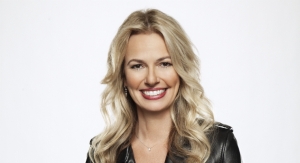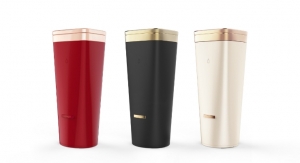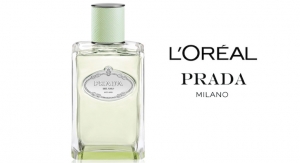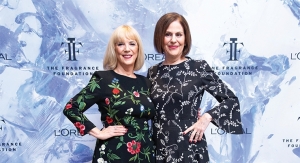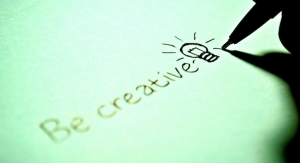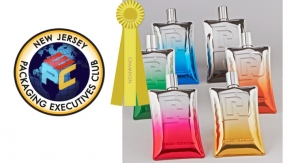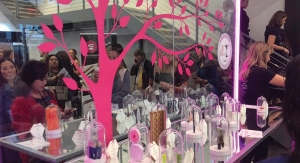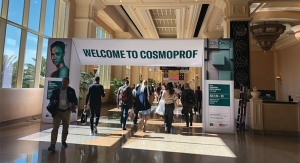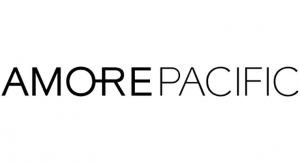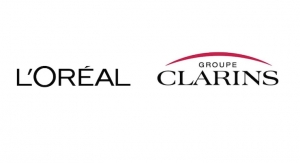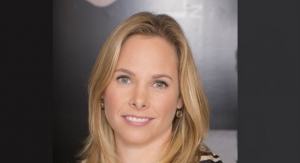By Jamie Matusow, with Joanna Cosgrove11.01.19
Update: L’Oréal ranks at #1 on our latest report Top 20 Global Beauty Companies 2020.
L'Oreal is #1 on this year's list of Top Global Beauty Companies.
Below is a look at the company's 2019 highlights, recent acquisitions, best-selling brands, and latest innovations.
Beauty Sales
$30.8 billion
Key Personnel
Major Products
L’Oréal Luxe, Consumer Products, Professional Products and Active Cosmetics in skincare, color cosmetics, sun care, hair care and fragrances, sold under many brand names in different channels, including:
New Products
Comments
Innovation and excellence remain L’Oréal’s modus operandi and, in 2018, aided in the world’s largest beauty company retaining its esteemed position at No. 1 on Beauty Packaging’s list of leading beauty companies, with global sales topping $30.8 billion—its best year in more than a decade, and outpacing the market in luxury, skincare and dermocosmetics. Total sales increased 3.5% and like-for-like sales increased 7.1%. The company also reached a record operating margin of 18.3%. Gains were reported in all divisions, led by double-digit increases by L’Oréal Luxe and Active Cosmetics. Lancôme sales crossed the 3-billion-euro mark.
By division, Consumer Products led with 44.7%, followed by L’Oréal Luxe (34.8%), Professional Products (12.1%) and Active Cosmetics (8.4%).
The Consumer Products Division’s three major brands— L’Oréal Paris, Maybelline and Garnier—are growing. Skincare is robust, with double-digit growth worldwide in facial skincare, thanks to Revitalift Filler by L’Oréal Paris, Garnier tissue masks and Men Expert skincare. Makeup growth continues, due in part to Maybelline New York and the global success of Superstay Matte Ink and Fit Me!. Hair care saw two successful launches with Elseve Dream Lengths and Fructis Hair Food. The Division is gaining market share in the U.S. and Eastern Europe, and continuing a rise in Asia.
L’Oréal Luxe sales grew by +14.4% like-for-like, with the division outperforming the market—and making 2018 “a historic year.” The Division’s four billionaire brands—Lancôme, Yves Saint Laurent, Giorgio Armani and Kiehl’s—achieved double-digit growth. Lancôme was led by its skincare, especially Génifique and Absolue, and the great success of La Vie est Belle.
L’Oréal Luxe captured market share in Asia Pacific, particularly in China where growth was double-digit.
The Professional Products Division grew in all geographic zones, except for Western Europe. Hair care is benefiting from the strong growth of Kérastase. Hair color is being driven by brands including Shades EQ by Redken.
The Active Cosmetics Division was up +11.9% like-for-like and continues to win market share across all geographic zones; it is moving “at a rapid pace,” with growth remaining strong in North America and in Asia. All the major brands are contributing to the division’s growth, including La Roche-Posay, Vichy and SkinCeuticals, which is strengthening its No. 1 position in professional skincare in the U.S. CeraVe is recording double-digit growth in North America, and has now been rolled out in more than 30 countries.
By business segment, Skincare topped the list at 31.8%, with Makeup (27.4%) next in line, followed by Hair Care (16.2%).
Western Europe (29.9%) proved to be the strongest geographic zone, over North America (26.9%—a +2.7% like-for-like growth). Asia-Pacific (27.5%) outpaced North America to become L’Oréal’s second largest zone in 2018, with all four L’Oréal divisions winning market share. Eastern Europe saw a 9.1% like-for-like improvement while Africa-Middle East was up 4.9% like-for-like.
Travel Retail broke the 2-billion-euro barrier with an increase of +27.1%. The category plays an ever-increasing role in overall revenue. At one point, Jean-Paul Agon, chairman and chief executive officer commented that the group’s travel-retail business is now so large, that if it were a country—sales-wise— it would follow the U.S. and China.
E-commerce was especially vibrant, with more than 3 billion euro in sales—a 40.6% like-for-like growth—accounting for 11% of Group sales. E-commerce accounted for over 35% of L’Oréal’s sales in China, up from about 10% just five years ago.
International acquisitions in 2018 included Valentino, Giorgio Armani Beauty, ModiFace, Logocos, Style Nanda and Pulp-Riot.
What trends made the year particularly strong? Agon says, “The first, and probably most important factor is the insatiable desire for beauty across all countries and cultures.” He also points to premiumization, digitalization (“as beauty and digital are a perfect match”) and “new consumer targets.”
Still, Agon says, “Delivering financial performance while being a committed corporate citizen is probably our greatest source of pride.” In 2018, L’Oréal received a number of accolades including for its actions in sustainability, fighting climate change, ensuring water security and combating deforestation; as the top gender-balanced company in Europe by Equileap; and as the leading company worldwide, across all industries, by Covalence EthicalQuote.
For the first time, L’Oréal offered its employees the chance to take a stake in the company’s financial capital via an employee share ownership plan.
In addition, by 2020, 100% of L’Oréal’s products will have “an improved environmental or social profile.” A program called SPOT, created by L’Oréal employees, is used to compile information on ingredients, packaging materials, suppliers and components. It is fully integrated into the product design process and can be used to assess and improve environmental impact. They have also started to reduce the weight and dimensions of packaging, particularly plastics, and to replace commonly used materials with alternatives when possible.
In line with its multi-year Sharing Beauty for All initiative, L’Oréal says 79% of new products in 2018 “have an improved environmental or social profile.”
2019 Highlights
In June 2019, L’Oréal appointed Delphine Viguier-Hovasse as global brand president for L’Oréal Paris, the first woman ever to take charge of the firm’s No.1 brand.
In July, L’Oréal and Clarins were rumored to be in talks about a possible acquisition of Clarins fine fragrances, Mugler and Azzaro. Interestingly, L’Oréal would also gain Mugler’s fashion business.
Also in July, in the pursuit of sustainable technologies, L’Oréal purchased a minority stake in Carbios, a company active in bio-industrial solutions “to reinvent the lifecycle of plastic and textile polymers.”
L’Oréal also announced plans for continued expansion in China. The French beauty giant said it will target its product range and geographic coverage to reach as many as 500 million Chinese consumers, compared with its current 100 million customer base.
In September, Stéphane Rinderknech was named president and CEO of L’Oréal USA, executive vice president North America, and a member of L’Oréal’s executive committee. He succeeds Frédéric Rozé and will report to him in his role as executive vice president Americas.
Also in September, Jamie Kern Lima announced she would be stepping down as CEO of IT Cosmetics, the brand she founded 11 years ago, and sold to L’Oréal for $1.2 billion in 2016. L’Oréal has not yet named a successor.
Looking Ahead
In the second quarter of 2019, a slowdown in North American sales, particularly of makeup brands, kept overall L’Oréal sales to 6.8%, $8.3 billion—and below the 7.4% growth predicted.But total Group sales in the first half of 2019 rose 10.6% to $16.8 billion.
In a statement, Agon said that the company “has delivered its strongest first-half like-for-like growth in more than a decade at plus 7.3 percent, outperforming a dynamic market which has, for the second year running, posted one of its highest-ever growth rates.”
All of the Group’s divisions achieved gains. In the half, sales rose 17.3% for L’Oréal Luxe, 15.1% for Active Cosmetics, 6.4% for Consumer Products and 5.1% for Professional Products.
On a like-for-like basis, L’Oréal’s e-commerce revenues rose 48.5%, making up 13.2% of total company sales; travel-retail sales grew 21.2%.
On a geographic basis, sales generated by New Markets increased 19.3%, 6.8% for North America and 1.9% for Western Europe.
“In a volatile and contrasted environment, this good first half gives us confidence in our capacity to outperform the market in 2019 and achieve another year of growth in sales and profits,” Agon said.
Read Next: Unilever is #2
L'Oreal is #1 on this year's list of Top Global Beauty Companies.
Below is a look at the company's 2019 highlights, recent acquisitions, best-selling brands, and latest innovations.
Beauty Sales
$30.8 billion
Key Personnel
- Jean-Paul Agon, chairman and chief executive officer
- Laurent Attal, executive vice president, research and innovation
- Cyril Chapuy, president, L’Oréal Luxe
- Vianney Derville, executive vice president, Western Europe Zone
- Nicolas Hieronimus, deputy chief executive officer, in charge of divisions
- Brigitte Liberman, president, Active Cosmetics Division
- Alexis Perakis-Valat, president, Consumer Products Division
- Delphine Viguier-Hovasse, global brand president, L’Oréal Paris
- Alexandre Popoff, executive vice president, Eastern Europe and Africa, Middle East
- Nathalie Roos, president, Professional Products
- Frédéric Rozé, executive vice president, Americas Zone
- Stéphane Rinderknech, president and CEO of L’Oréal USA, executive vice president North America
- Ali Goldstein, president, L’Oréal Paris USA
- Jochen Zaumseil, executive vice president, Asia-Pacific
Major Products
L’Oréal Luxe, Consumer Products, Professional Products and Active Cosmetics in skincare, color cosmetics, sun care, hair care and fragrances, sold under many brand names in different channels, including:
- Garnier, L’Oréal Paris, Le Club des Créateurs
- Maybelline, Essie, L’Oréal Professional
- Kerastase, Redken, Matrix
- Mizano, Lancôme, Biotherm
- Kiehl’s, Giorgio Armani, Ralph Lauren
- Viktor & Rolf, Diesel, YSL Beauté, Vichy
- LaRoche-Posay and SkinCeuticals, Giorgio Armani Beauty, Modiface
New Products
- Seed Phytonutrients
- La Provençale Bio
- L’Oréal Paris Infallible Fresh Wear Foundation
- L’Oréal Paris Unbelievabrow
- Garnier Fructis Sleek & Shine Zero Shampoo
- Maybelline New York x Ashley Longshore collection
- Lancôme Idôle Eau de Parfum
- Elseve Dream Lengths
- Fructis Hair Food
Comments
Innovation and excellence remain L’Oréal’s modus operandi and, in 2018, aided in the world’s largest beauty company retaining its esteemed position at No. 1 on Beauty Packaging’s list of leading beauty companies, with global sales topping $30.8 billion—its best year in more than a decade, and outpacing the market in luxury, skincare and dermocosmetics. Total sales increased 3.5% and like-for-like sales increased 7.1%. The company also reached a record operating margin of 18.3%. Gains were reported in all divisions, led by double-digit increases by L’Oréal Luxe and Active Cosmetics. Lancôme sales crossed the 3-billion-euro mark.
By division, Consumer Products led with 44.7%, followed by L’Oréal Luxe (34.8%), Professional Products (12.1%) and Active Cosmetics (8.4%).
The Consumer Products Division’s three major brands— L’Oréal Paris, Maybelline and Garnier—are growing. Skincare is robust, with double-digit growth worldwide in facial skincare, thanks to Revitalift Filler by L’Oréal Paris, Garnier tissue masks and Men Expert skincare. Makeup growth continues, due in part to Maybelline New York and the global success of Superstay Matte Ink and Fit Me!. Hair care saw two successful launches with Elseve Dream Lengths and Fructis Hair Food. The Division is gaining market share in the U.S. and Eastern Europe, and continuing a rise in Asia.
L’Oréal Luxe sales grew by +14.4% like-for-like, with the division outperforming the market—and making 2018 “a historic year.” The Division’s four billionaire brands—Lancôme, Yves Saint Laurent, Giorgio Armani and Kiehl’s—achieved double-digit growth. Lancôme was led by its skincare, especially Génifique and Absolue, and the great success of La Vie est Belle.
L’Oréal Luxe captured market share in Asia Pacific, particularly in China where growth was double-digit.
The Professional Products Division grew in all geographic zones, except for Western Europe. Hair care is benefiting from the strong growth of Kérastase. Hair color is being driven by brands including Shades EQ by Redken.
The Active Cosmetics Division was up +11.9% like-for-like and continues to win market share across all geographic zones; it is moving “at a rapid pace,” with growth remaining strong in North America and in Asia. All the major brands are contributing to the division’s growth, including La Roche-Posay, Vichy and SkinCeuticals, which is strengthening its No. 1 position in professional skincare in the U.S. CeraVe is recording double-digit growth in North America, and has now been rolled out in more than 30 countries.
By business segment, Skincare topped the list at 31.8%, with Makeup (27.4%) next in line, followed by Hair Care (16.2%).
Western Europe (29.9%) proved to be the strongest geographic zone, over North America (26.9%—a +2.7% like-for-like growth). Asia-Pacific (27.5%) outpaced North America to become L’Oréal’s second largest zone in 2018, with all four L’Oréal divisions winning market share. Eastern Europe saw a 9.1% like-for-like improvement while Africa-Middle East was up 4.9% like-for-like.
Travel Retail broke the 2-billion-euro barrier with an increase of +27.1%. The category plays an ever-increasing role in overall revenue. At one point, Jean-Paul Agon, chairman and chief executive officer commented that the group’s travel-retail business is now so large, that if it were a country—sales-wise— it would follow the U.S. and China.
E-commerce was especially vibrant, with more than 3 billion euro in sales—a 40.6% like-for-like growth—accounting for 11% of Group sales. E-commerce accounted for over 35% of L’Oréal’s sales in China, up from about 10% just five years ago.
International acquisitions in 2018 included Valentino, Giorgio Armani Beauty, ModiFace, Logocos, Style Nanda and Pulp-Riot.
What trends made the year particularly strong? Agon says, “The first, and probably most important factor is the insatiable desire for beauty across all countries and cultures.” He also points to premiumization, digitalization (“as beauty and digital are a perfect match”) and “new consumer targets.”
Still, Agon says, “Delivering financial performance while being a committed corporate citizen is probably our greatest source of pride.” In 2018, L’Oréal received a number of accolades including for its actions in sustainability, fighting climate change, ensuring water security and combating deforestation; as the top gender-balanced company in Europe by Equileap; and as the leading company worldwide, across all industries, by Covalence EthicalQuote.
For the first time, L’Oréal offered its employees the chance to take a stake in the company’s financial capital via an employee share ownership plan.
In addition, by 2020, 100% of L’Oréal’s products will have “an improved environmental or social profile.” A program called SPOT, created by L’Oréal employees, is used to compile information on ingredients, packaging materials, suppliers and components. It is fully integrated into the product design process and can be used to assess and improve environmental impact. They have also started to reduce the weight and dimensions of packaging, particularly plastics, and to replace commonly used materials with alternatives when possible.
In line with its multi-year Sharing Beauty for All initiative, L’Oréal says 79% of new products in 2018 “have an improved environmental or social profile.”
2019 Highlights
In June 2019, L’Oréal appointed Delphine Viguier-Hovasse as global brand president for L’Oréal Paris, the first woman ever to take charge of the firm’s No.1 brand.
In July, L’Oréal and Clarins were rumored to be in talks about a possible acquisition of Clarins fine fragrances, Mugler and Azzaro. Interestingly, L’Oréal would also gain Mugler’s fashion business.
Also in July, in the pursuit of sustainable technologies, L’Oréal purchased a minority stake in Carbios, a company active in bio-industrial solutions “to reinvent the lifecycle of plastic and textile polymers.”
L’Oréal also announced plans for continued expansion in China. The French beauty giant said it will target its product range and geographic coverage to reach as many as 500 million Chinese consumers, compared with its current 100 million customer base.
In September, Stéphane Rinderknech was named president and CEO of L’Oréal USA, executive vice president North America, and a member of L’Oréal’s executive committee. He succeeds Frédéric Rozé and will report to him in his role as executive vice president Americas.
Also in September, Jamie Kern Lima announced she would be stepping down as CEO of IT Cosmetics, the brand she founded 11 years ago, and sold to L’Oréal for $1.2 billion in 2016. L’Oréal has not yet named a successor.
Looking Ahead
In the second quarter of 2019, a slowdown in North American sales, particularly of makeup brands, kept overall L’Oréal sales to 6.8%, $8.3 billion—and below the 7.4% growth predicted.But total Group sales in the first half of 2019 rose 10.6% to $16.8 billion.
In a statement, Agon said that the company “has delivered its strongest first-half like-for-like growth in more than a decade at plus 7.3 percent, outperforming a dynamic market which has, for the second year running, posted one of its highest-ever growth rates.”
All of the Group’s divisions achieved gains. In the half, sales rose 17.3% for L’Oréal Luxe, 15.1% for Active Cosmetics, 6.4% for Consumer Products and 5.1% for Professional Products.
On a like-for-like basis, L’Oréal’s e-commerce revenues rose 48.5%, making up 13.2% of total company sales; travel-retail sales grew 21.2%.
On a geographic basis, sales generated by New Markets increased 19.3%, 6.8% for North America and 1.9% for Western Europe.
“In a volatile and contrasted environment, this good first half gives us confidence in our capacity to outperform the market in 2019 and achieve another year of growth in sales and profits,” Agon said.
Read Next: Unilever is #2

